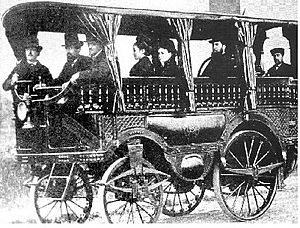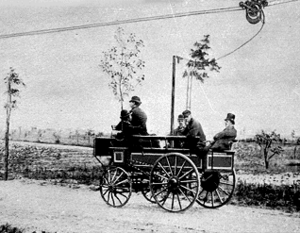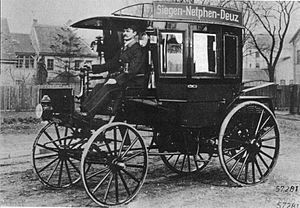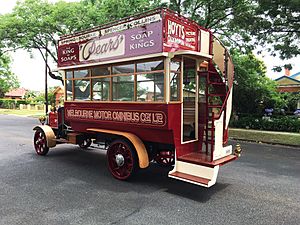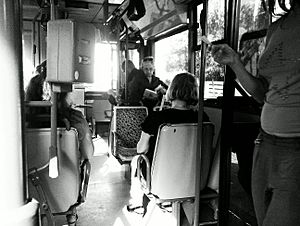Bus facts for kids
A bus is a big vehicle with wheels that carries many people and a driver. It's bigger than a car. The word "bus" is short for "omnibus," which comes from Latin and means "for everyone." People used to call them omnibuses, but now we just say "buses."
Buses are a really important part of public transport all over the world. Many people who don't have cars, especially in developing countries, use buses to get around. Buses make it easy for them to travel to different places.
A place on the sidewalk where people wait for a local bus is called a bus stop. A bigger building where people wait for buses that travel long distances, or where many buses meet, is called a bus station.
There are many different kinds of buses around the world.
Contents
History of Buses
Steam Buses
The first regular bus services using steam power started in England in the 1830s. People like Walter Hancock and Goldsworthy Gurney created these early steam buses. They could travel on roads that were too rough for horse-drawn vehicles.
The very first bus powered by a machine appeared in London on April 22, 1833. These steam vehicles were safer, faster, and cheaper to run than horse-drawn carriages. They also caused less damage to the roads because their tires were wide.
However, high fees on toll roads made it hard for steam buses to succeed. Also, a strict law called the Locomotive Act in 1861 made it almost impossible for these vehicles to be on British roads for 30 years. This law set very slow speed limits, like 5 miles per hour in cities.
Trolleybuses
At the same time, the electric trolleybus was invented. These buses get their power from overhead wires using special poles. The Siemens brothers, William in England and Ernst Werner in Germany, worked together on this idea. William Siemens first suggested it in 1881.
His brother, Ernst Werner von Siemens, built the first such vehicle, called the Electromote, and showed it to the public in 1882 in Halensee, Germany. Even though this experimental bus worked well, it was taken apart that same year.
Max Schiemann opened a trolleybus service for passengers in 1901 near Dresden, Germany. He developed the system that most trolleybuses still use today to collect electricity. The cities of Leeds and Bradford in Great Britain started using trolleybuses on June 20, 1911.
Motor Buses
In Germany, two bus lines briefly ran in 1895 using a six-passenger motor vehicle. It was based on the 1893 Benz Viktoria car. Another bus line using the same type of Benz buses operated for a short time in 1898 in Llandudno, Wales.
Daimler also made one of the first motor buses in 1898. They sold a double-decker bus to the Motor Traction Company. This bus was first used in London on April 23, 1898. It could go up to 18 kilometers per hour and carry up to 20 passengers. Daimler then made more buses for London, Stockholm, and Speyer.
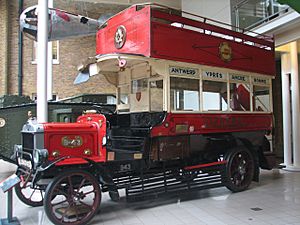
The first bus made in large numbers was the LGOC B-type double-decker bus. It was designed by Frank Searle and used by the London General Omnibus Company. It started service in 1910, and nearly 3,000 were built by 1920. Many of these buses were even used by the military during World War I.
The Yellow Coach Manufacturing Company became a big bus maker in the US. It was started in Chicago in 1923 by John D. Hertz. General Motors bought most of the company in 1925.
Bus designs kept improving in the 20th century. By the 1950s, buses looked much like the ones we see today. The AEC Routemaster, made in the 1950s, was a very important design. It's still a famous symbol of London. This bus was built using lightweight aluminum, similar to how airplanes were made during World War II. It also had new features like independent suspension for the front wheels, power steering, an automatic gearbox, and power brakes.
Types of Buses
There are many different kinds of buses, each designed for a special purpose:
- Coach / Motorcoach - These buses are made for long trips and are very comfortable. They usually have fewer doors than city buses and more space for luggage.
- School bus - This bus takes students to their school or university. In America, school buses are usually yellow, but they can be different colors in other countries.
- Shuttle buses - These buses travel between specific places without many stops. They are often used for sport events, concerts, or at airports.
- Minibus - A minibus is smaller than a regular bus. It can carry about 8 to 25 people.
- Double-decker bus - This bus has two floors, or "decks." It can carry around 70 people.
- Low-floor bus - This type of bus is closer to the ground, which makes it easier for people to get on and off, especially those with wheelchairs or strollers. These buses are often used in cities. The floor might even lower when the bus stops and rise when it moves.
- Trolleybus - A trolleybus gets its power from electric cables above the street, not from petroleum fuel.
- Articulated bus - This bus can bend in the middle, like a train. This allows it to be very long and still turn easily on smaller streets.
- Guided bus - A guided bus can run on special tracks, similar to a train. This helps it stay in line at bus stops. It can often also be driven like a normal bus on regular roads.
- Neighbourhood bus - This is similar to a school bus, often serving local areas.
- Training bus - This bus is used to teach new drivers how to operate a bus. It might not be safe for passengers and could have special controls for the instructor.
- Gyrobus - To learn more, see Gyrobus.
- Hybrid bus - A hybrid bus has two types of engines, for example, a fuel engine and an electric engine, to save energy.
- Police bus - This bus is used by the police to transport many police officers.
- Offroad bus - An offroad bus is built to travel on rough terrain, not just normal roads. It's often used by the Army.
- Open-top bus - This bus has no roof and is often used for tourism, giving passengers a great view.
Images for kids
-
A New Routemaster double-decker bus, operating for Arriva London on London Buses route 73.
-
A Toronto Transit Commission bus system trolleybus in Toronto.
-
Interior of an articulated bus in Los Angeles.
-
An example of a private bus operating for BusWest in Perth.
-
The Knight Bus, seen in the Harry Potter and the Prisoner of Azkaban film, at Warner Bros. Studios, Leavesden.
-
A retired bus used as an ambulance bus in Toronto.
See also
 In Spanish: Autobús para niños
In Spanish: Autobús para niños


